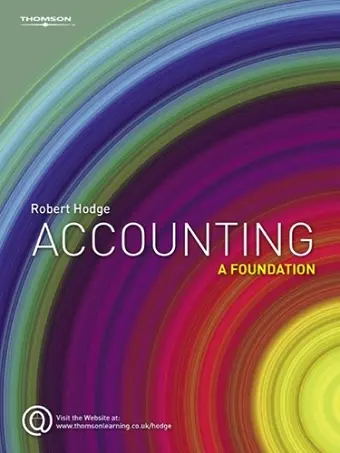Accounting
A Foundation
Format:Paperback
Publisher:Cengage Learning EMEA
Published:8th May '08
Currently unavailable, and unfortunately no date known when it will be back

Accounting: A Foundation is written for any student starting a course of study in bookkeeping and accounting. Based on a new interpretation of the accounting model, the book begins with a clear and coherent introduction to double entry. It then uses the new model to describe and illustrate the financial workings of the limited company. As a general introduction, the book covers the accounting knowledge required by non-specialist students of business and management as well as those who will go on to study accounting in depth. In UK further education, the book is suitable for courses aimed at AAT Foundation, BTEC HND, A-Level, RSA, LCCI, GCSE, and introductory levels of the main professional bodies such as ACCA, CIMA, ICSA, CIPFA and the main English, Scottish and Irish professional bodies - the ICAEW, the ICAS and the ICAI. In effect this means anywhere that a knowledge of the technical aspects of bookkeeping is required. There are equivalent courses at this level in all countries of the world. In higher education the book is suitable for undergraduate courses in accounting and business where the tutor wishes to teach the technical background to accounting thoroughly. This readership extends to the non-specialist market, as some teachers wish to teach double entry to students even though they may be on an appreciation course. Undergraduates who specialise in accounting, eg those doing a BA Accounting and Finance (in Europe the Economics route) or combined/joint degree with languages will need to study the technical aspects of accounting in depth in order to progress to modules on intermediate and advanced accounting.
PART 1. INTRODUCTION. 1. Introduction. 2. The Double Entry Model of a Business. 3. Money and Value. PART 2. RECORDING EVENTS. 4. Analysing Simple Cash Transactions. 5. Credit and the Use of Promises. 6. Bank and Cheque Transactions. 7. Borrowing, Lending and Interest. 8. Involuntary Liabilities and One-Way Transactions. 9. Timing: When to Record a Transaction. 10. Transactions between a Firm and Its Owner. 11. Recording Transactions in Separate Accounts. 12. Corrections and Transfers between Accounts. 13. Debits and Credits; Balancing an Account. 14. Reading Ledger Accounts. 15. The Trial Balance. 16. A Profit & Loss Account with Closing Stock. 17. Profit and the Accounting Equation. 18. A Simple Balance Sheet. 19. Opening Stock and Cost of Sales. 20. Stock and Profit. 21. Elements of the Full Length Profit & Loss Account. 22. The Income Statement and The P&L Account. 23. Three Levels of Profit. 24. The Extended Trial Balance. PART 3. REPORTING RESULTS. 25. An Introduction to Accounting Principles. 26. The Presentation of the Balance Sheet. 27. Fixed Assets and Depreciation. 28. The Provision for Depreciation Account. 29. Accounting for Fixed Asset Disposals. 30. Fixed Asset Disposals (Quick Method). 31. Estimating Annual Depreciation. 32. Revenue and Capital 33. Depreciation in Context. 34. Profits Losses and Movements of Money. 35. Accruals and Prepayments. 36. Deferred Income and Accrued Income. 37. Accruals, etc, in the Extended Trial Balance. 38. Accruals, etc as Time-Shifts. 39. Accounting Software and Post-Trial Balance Adjustments. 40. Matching: Accruals etc in Context. 41. Provisions and Potential Liabilities. 42. Maintaining, Changing, or Releasing a Provision. 43. Transactions that have been Provided For. 44. Using Provisions For Their Effect on the P& L Account. 45. Rolling Provisions. 46. The Misuse of Provisions. 47 Accounting For Discounts. 48. Bad Debt Write-Off and Recovery. 49. Provision for Doubtful Debts. 50. Specific Provisions and Year-End Accounting for Debtors. 51. Accounting for VAT. 52. Cost of Sales in a Manufacturing Firm. 53. Stock Valuation: Cost & Net Realisable Value. 54. Stock Flow Assumptions: LIFO, FIFO, & AVCO. 55. Production Overheads and Stock. PART 4. THE LIMITED COMPANY. 56. Insolvency and Its Consequences. 57. Incorporation & The Limited Company. 58. The Issues of Shares in a New Company . 59. Accounting for Profits & Losses. 60.. Accounting for Dividends. 61. Capital Maintenance and Dividend Policy. 62. The Market Value as a Share. 63. Rights Issues. 64. Debentures, Preference Shares and Earnings. 65. Equity, Share, Capital and Reserves. 66. Reserves & Bones Issues. 67. Additional Financial Statements. PART 5. RATIOS AND READING COMPANY ACCOUNTS. 68. Profitability. 69. Gearing and the Effects of Borrowing. 70. The Gearing Ratio. 71. Working Capital & Liquidity. 72. The Working Capital Cycle. 73. Profit & Sales Ratios. 74. Investment Ratios. PART 6. CONCLUSION. 75. Next Steps: Accounting Standards. 76. Further Reading.
ISBN: 9781844808052
Dimensions: 25mm x 193mm x 259mm
Weight: 1180g
512 pages
Documentation Update Edition